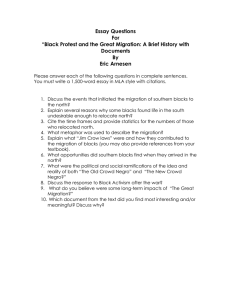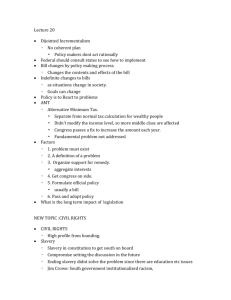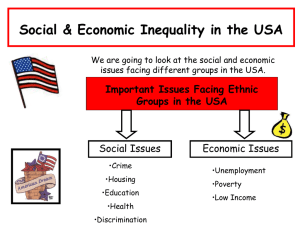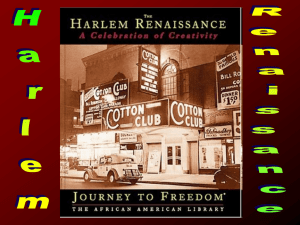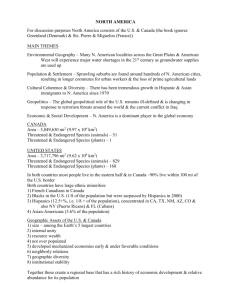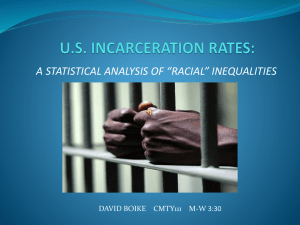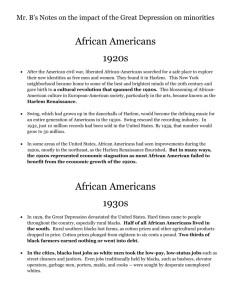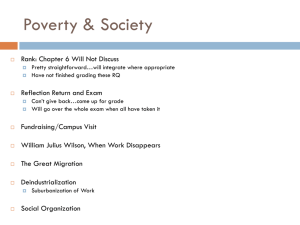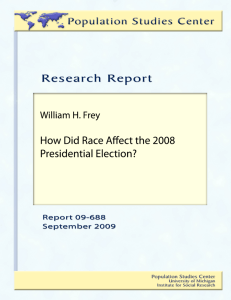ch04
advertisement
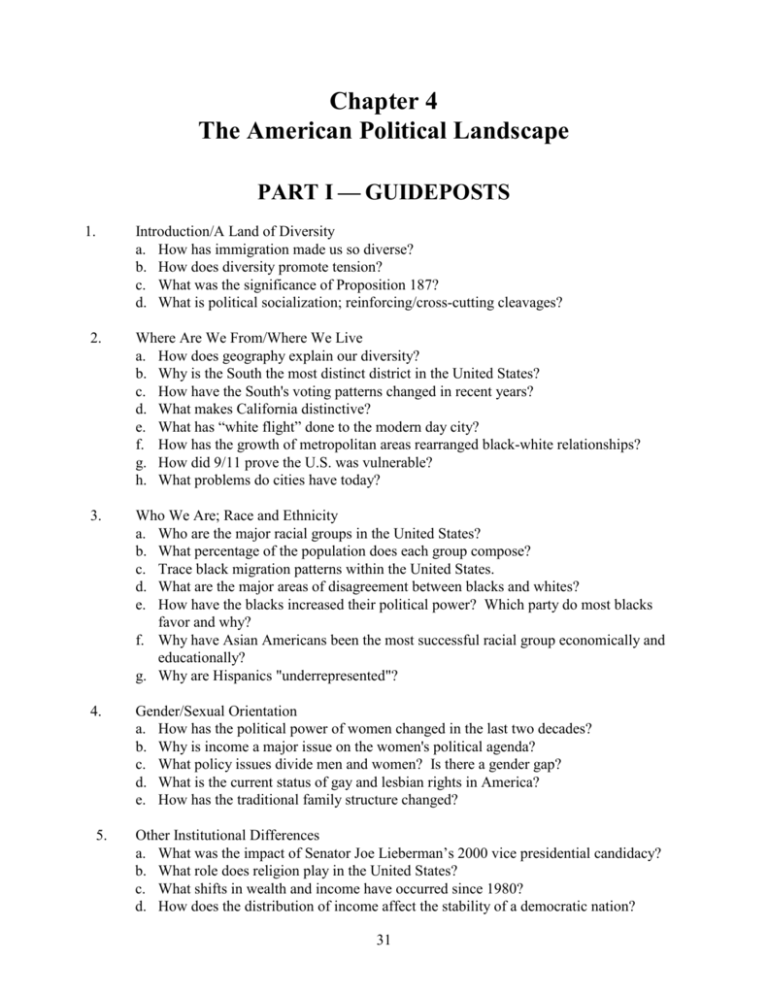
Chapter 4 The American Political Landscape PART I — GUIDEPOSTS 1. Introduction/A Land of Diversity a. How has immigration made us so diverse? b. How does diversity promote tension? c. What was the significance of Proposition 187? d. What is political socialization; reinforcing/cross-cutting cleavages? 2. Where Are We From/Where We Live a. How does geography explain our diversity? b. Why is the South the most distinct district in the United States? c. How have the South's voting patterns changed in recent years? d. What makes California distinctive? e. What has “white flight” done to the modern day city? f. How has the growth of metropolitan areas rearranged black-white relationships? g. How did 9/11 prove the U.S. was vulnerable? h. What problems do cities have today? 3. Who We Are; Race and Ethnicity a. Who are the major racial groups in the United States? b. What percentage of the population does each group compose? c. Trace black migration patterns within the United States. d. What are the major areas of disagreement between blacks and whites? e. How have the blacks increased their political power? Which party do most blacks favor and why? f. Why have Asian Americans been the most successful racial group economically and educationally? g. Why are Hispanics "underrepresented"? 4. Gender/Sexual Orientation a. How has the political power of women changed in the last two decades? b. Why is income a major issue on the women's political agenda? c. What policy issues divide men and women? Is there a gender gap? d. What is the current status of gay and lesbian rights in America? e. How has the traditional family structure changed? 5. Other Institutional Differences a. What was the impact of Senator Joe Lieberman’s 2000 vice presidential candidacy? b. What role does religion play in the United States? c. What shifts in wealth and income have occurred since 1980? d. How does the distribution of income affect the stability of a democratic nation? 31 e. f. g. h. i. j. 6. Why is poverty a political issue? What distinctions exist between an industrial society and a post-industrial society? What are the occupational patterns of women and racial minorities? Why has social class been relatively unimportant in the United States? Why have the elderly been such a political success? How important is education to a diverse society? Unity in a Land of Diversity a. What factors unify our diverse population? b. How does the melting pot theory differ from the salad bowl theory? Which best describes the United States? PART II — PRETEST 1. The tendency of every person to make sweeping judgments based on their limited personal experience is called a. ethnocentricism. b. wisdom. c. experience. d. selfishness. 2. The most distinct geographical region in the United States is the a. Midwest. c. South. b. Southwest. d. West. 3. Only one of these cities does not have a majority black population? a. Phoenix c. Richmond b. Baltimore d. New Orleans 4. Which of the following is not a gender issue? a. sexual harassment b. child support c. peace d. English as the official language 5. The most politically underrepresented group has been a. Asians. b. blacks. c. Hispanics. d. women. 6. The most potent politically active group has been a. college students. b. the elderly. c. the poor. d. the common man. 7. A popular theory that explains the unity achieved by Americans is the a. salad bowl. c. welding. b. melting pot. d. ethnicity. 8. Compared to most industrialized countries the United States does not have a high degree of 32 __________ awareness a. social class b. religious intolerance c. personal achievement d. acceptance of a leisure class 9. In recent years the South has given its vote for president to a. Republicans. c. no decisive pattern. b. Democrats. d. varied. 10. Black migration from the South occurred chiefly after a. 1865. b. 1950. c. 1970. d. 1900. PART III — PROGRAMMED REVIEW Knowledge Objective: To trace the roots of the American people 1. Proposition 187 in California dealt with the issue of __________. 2. The tendency to generalize from our own experience is called __________. 3. The belief that we have a foreordained role to become a world power is called __________. 4. The most distinct section of the United States is the __________. 5. After the Civil War the South normally supported the __________ party. 6. The West has developed a strong sense of __________. 7. Most Americans now live in ___________ areas. 8. The migration of white Americans to the suburbs after World War II is known as the __________ __________. 9. Migration of the whites from the cities has resulted in a(n) __________ tax base. Knowledge Objective: To distinguish the various elements in our diverse society 10. Children normally learn their political values within the __________. 11. When cultural values are in conflict the result is called __________ __________ cleavages. 12. Politically, the United States compared to Ireland has less emphasis on __________. 13. The first Jewish vice presidential candidate for a major party was Senator _____ in 2000. 14. The mass migration of blacks to the city gave them greater __________ power but left them with limited __________ power. 15. Nearly __________ of the blacks fall below the poverty level. 16. According to the text, Hispanics are politically _____________. 17. Hispanics can be of any __________. 18. Generally speaking older ethnic groups have greater __________ power than newer ethnic groups. 19. Compared to the women in other countries, American women vote __________ (more, less). 20. The largest segment of Americans are __________. 21. Women for the most part (do, do not) __________ support female candidates. 22. As women age, the earnings gap __________. 23. Significant political difference between men and women is called the __________. 33 24. A defining characteristic of religion in America is the variety of __________. 25. African-Americans traditionally support the _______ Party. Knowledge Objective: To investigate social and economic differences 26. Widespread income distribution results in political __________. 27. One of the most important means for Americans to achieve economic and social mobility is __________. 28. Originally most Americans worked as __________. 29. Today America is known as a __________ society. 30. In terms of social class most Americans believe that they are __________ class. 31. In recent years the American Dream has been challenged by foreign __________. PART IV — POST-TEST 1. Democratic strengths in the South have been greatest in elections for a. president. c. representative. b. U.S. Senate. d. no pattern. 2. The state with the largest population is a. New York. b. Pennsylvania. c. California. d. Texas. 3. Fundamentalist Christians have an agenda that includes all but one of the following. a. return of school prayer c. outlaw guns b. outlaw abortion d. restrict homosexuals 4. The population of American cities has all but one of the following characteristics. a. poor c. independent b. black d. democratic 5. Black unemployment is a result of all but one of the following. a. limited education c. depressed urban areas b. youth d. limited political power 6. Most Asian Americans live in all but one of the following states. a. Michigan c. Washington b. Hawaii d. California 7. Recent Asian-American migration has been from all but one of the following. a. Korea c. Asia b. Japan d. Southeast 8. The fastest growing ethnic group in the United States is a. Hispanics. c. Asian b. African Americans. d. Native Americans. 34 9. The gray lobby has all but one of these political assets. a. mostly male b. disposable income c. discretionary time d. focused issues 10. American unity is strengthened by all but one of the following. a. the American Dream c. economic opportunity b. work ethic d. foreign investment PART V — TEST ANSWERS Pretest 1. 2. 3. 4. 4. a c a d b 6. 7. 8. 9. 10. b b a a b immigration Ethnocentricism manifest destiny South Democratic Individualism Metropolitan white flight declining family cross-cutting religion Lieberman political; economic one third underrepresented 17. 18. 19. 20. 21. 22. 23. 24. 25. 26. 27. 28. 29. 30. 31. race economic less women do not widens gender gap denominations Democratic stability education farmers post-industrial middle competition c c c c d 6. 7. 8. 9. 10. a b a a d Programmed Review 1. 2. 3. 4. 5. 6. 7. 8. 9. 10. 11. 12. 13. 14. 15. 16. Post-test 1. 2. 3. 4. 5. 35
